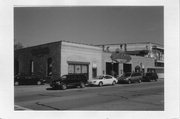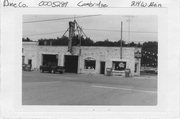Property Record
214 W MAIN ST (US HIGHWAY 12)
Architecture and History Inventory
| Historic Name: | D.W. SCOBIE WAGON WORKS |
|---|---|
| Other Name: | WAGON FACTORY MERCANTILE |
| Contributing: | |
| Reference Number: | 5289 |
| Location (Address): | 214 W MAIN ST (US HIGHWAY 12) |
|---|---|
| County: | Dane |
| City: | Cambridge |
| Township/Village: | |
| Unincorporated Community: | |
| Town: | |
| Range: | |
| Direction: | |
| Section: | |
| Quarter Section: | |
| Quarter/Quarter Section: |
| Year Built: | 1892 |
|---|---|
| Additions: | |
| Survey Date: | 1999 |
| Historic Use: | industrial building |
| Architectural Style: | Commercial Vernacular |
| Structural System: | |
| Wall Material: | Stone - Unspecified |
| Architect: | |
| Other Buildings On Site: | |
| Demolished?: | No |
| Demolished Date: |
| National/State Register Listing Name: | Not listed |
|---|---|
| National Register Listing Date: | |
| State Register Listing Date: |
| Additional Information: | WIDE SEGMENTAL ARCHED WINDOW. SEGMENTAL ARCHES ABOVE DOORWAYS. According to the datestone, the structure was constructed for D.W. Scobie in 1892. David W. Scobie was born in Scotland in 1842. His family immigrated to the U.S. and settled in Cambridge before the Civil War. Service in the war interrupted Scobie's training as a blacksmith; however, he eventually completed his apprenticeship and opened a small smithy in Cambridge during 1868. Success followed as Scobie operated a shop with as many as seven employees and had secured a patent on a flexible harrow by 1880. By 1892, his success enabled him to construct the extant structure--believed initially to have included both halves. Scobie's business manufactured wagons, carriages and sleighs. A Sanborn map from 1909 portrays the building as an expansive facility with separate sections clearly delineated for blacksmithing, painting, flour storage, wagonmaking, agricultural implements storage (west block), and office space. Scobie also utilized additional building space across the street for his business. Sometime after 1907, Scobie's son, James, took over the complex. Business directories suggest that James Scobie was no longer involved with the enterprise by 1917. While Scobie was ending his operation, Jerald H. Simonsen began a garage and car dealiership in Cambridge. Although he did not start his business in Scobie's building, according to newspaper advertisements, he moved into the subject structure in 1920. In addition, a historic photograph clearly shows Simonsen's Chevrolet Garage operating within the structure by 1925. A Sanborn map from 1932 indicates that the facility continued to serve as an auto sales and service enterprise with a repair shop. Even during the Great Depression, Simonsen maintained such a profitable business that his enterprise received anecdotal recognition in Time magazine in 1936. The establishment remained in the Simonsen family through the 1970s. Subsequently, the building continued to function as a car dealership until it was damaged by fire in 1992. The next year, Don and Linda Korth rehabilitated the structure as an antique mall. |
|---|---|
| Bibliographic References: | Historic name and construction date from stone inset. Cambridge Walking Tour brochure. Architecture/History Survey. September 1999. Prepared by Heritage Research, Ltd. |
| Wisconsin Architecture and History Inventory, State Historic Preservation Office, Wisconsin Historical Society, Madison, Wisconsin |


